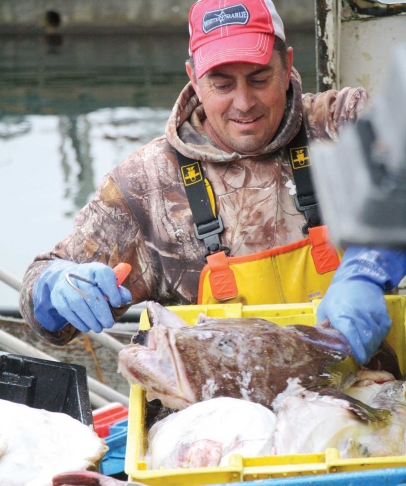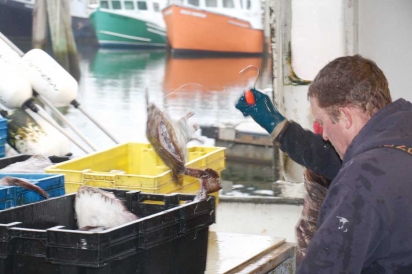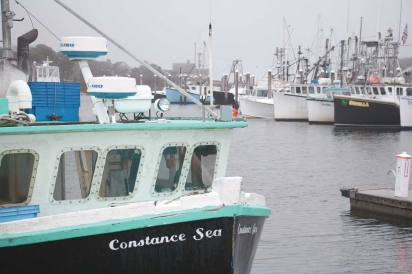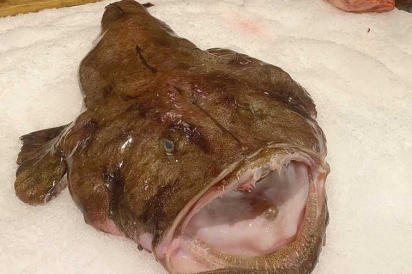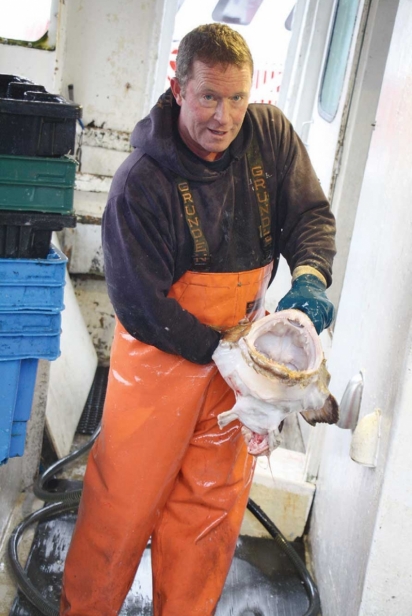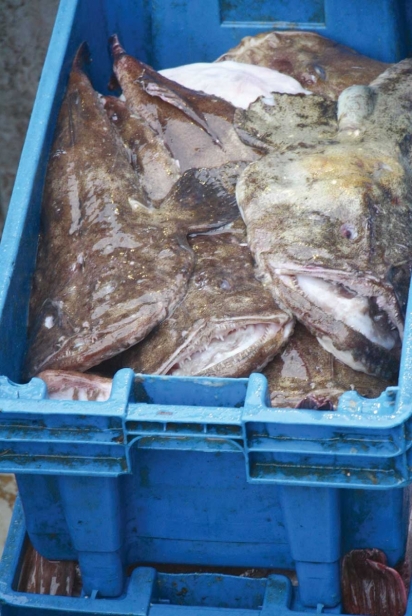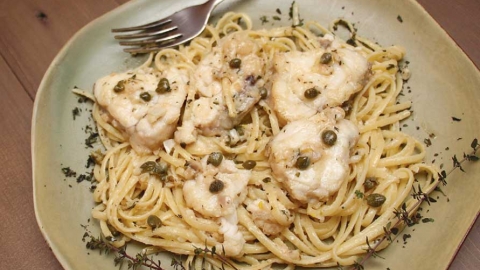Not Just Another Pretty Face
Sometimes, good things come in very curious packages. The monkfish is a prime example. There’s just no pleasant way to put it: this is one dreadful-looking fish. In an undersea world filled with oddities, the monkfish reigns supreme. It’s as if it was cobbled together with what was leftover in the assembly shop. Attach the over-sized mouth of a shark to one side of a frying pan, and a tail to the other and you start to get an idea of just how unfortunate one fish can look. This isn’t even a case of “so ugly it’s cute” that you might find at a World’s Ugliest Dog contest. Once you look past, well, everything on the outside, you get to see a truly wondrous animal that can play a vital part in our health and the long-term sustainability of the fisheries on which we rely.
The monkfish (Lophius americanus) has many names such as “goosefish”, the very apt “allmouth”, and “fishing frog” which it does resemble if Wyle E. Coyote dropped an anvil on a large bullfrog. The monkfish’s appearance does play a key role in its survival, however. This groundfish spends most of its time on the sandy or muddy bottom of the ocean where it burrows in to lie in wait for its next meal. Monkfishes’ stomachs are expandable and allow them to eat animals nearly their own size, including other monkfish. Often thought of as strictly bottom dwellers, seabirds found in their bellies prove that monkfish do come up near the water’s surface often. This industrious fish, however, doesn’t merely hope for a chance encounter. Also known as the “angler fish”, monkfish have an adapted spine protruding from their heads with an irregular growth on the end that acts as bait to draw in their prey. One mighty gulp, and the quarry is swallowed whole. A large female can grow to nearly five feet long. Some can weigh as much as fifty pounds or more and have few natural predators. Their strong pectoral fins allow them to walk along the bottom or ride the currents during migration.
Monkfish is one of those species of fish, along with dogfish and skate, that are a flavorful alternative to other fish that have struggled to withstand overfishing. For captains like Greg Connors and his boat the Constance Sea, the winter months are spent hunting monkfish well south of Cape Cod. “We’ll spend the summer up north going for skates and dogs,” Connors explains. For a commercial fisherman, which species to fish for is an equation of price point and proximity. “In the summer, the dogs and skates are five to fifteen miles off Chatham. We can get out there six, seven days a week, and it’s only a six- or seven-hour day,” he states. “In the winter we’ll go for skates and monks. It rounds out the year.” Connors and his crew of three travel between 75 and 105 miles south for their target fish in the winter, making for a 28-36 hour round trip. The crew sets sixty nets or more at different depths for either skates or monkfish, spanning three miles. Crew members have to be on alert as they disentangle the live monkfish from the gillnets once onboard. Rows of hundreds of razor-sharp teeth are just waiting to chomp down on the fingers of a distracted fisherman.
For the consumer, which species to shop for is an equation of price point and flavor. Monkfish is known as “the poor man’s lobster”. The tail’s texture and flavor are very similar to lobster meat, and is what you’ll find at local fish markets like Chatham Fish & Lobster. The price per pound is a fraction of lobster meat. The problem is that you won’t find monkfish at many fish markets. The challenge is growing the ranks of domestic buyers. As one fishmonger says, “We get it in occasionally. It either sells out really fast, or I end up throwing out all of it.” The vast majority of monkfish landed locally is destined for Asian markets. Dogfish is similar in that way. It’s shipped to Britain for use in the county’s iconic fish & chips.
Fisheries management and their regulations are ever-changing in their quest to protect the fish stocks for future generations while still finding a way to make fishing financially feasible for the fishers of today. It’s a nearly impossible target to hit because the ocean is such a dynamic environment. Limits on days at sea or fish quotas (catch limits) can help protect the big three of groundfish: cod, haddock, and yellowtail flounder. Another way to safeguard their numbers is to turn people on to alternatives. As Captain Connors says, “There’s a ton of protein out there. It’s just not in the form people want.” He goes on to say, “We need to be changing the minds of the people that consume what’s in the ocean.”
Cape Cod Commercial Fishermen’s Alliance (CCCFA) is working to shine a light on this mysterious fish. A recent remote “Meet the Fleet” cooking class featuring Chef Tyler Hadfield of The Rail in Orleans went a long way in lifting the veil on this fish, and more importantly, what you can do with it in the kitchen. “I’ll use it as a special at times,” Hadfield explains. “It’s a nice fish. It holds up to heavy sauces like a Newburg or in stews or bouillabaisse or cioppinos. It won’t flake out like cod will.”
Tyler and his brother, Cameron, opened The Rail in April of 2021. Both Hadfields got their start early thanks to their aunt who put them to work at The Squire in Chatham. Through their teen years, Cam gravitated towards working the front of the house, and Tyler to the kitchen. After further expanding his credentials in Colorado, Tyler moved back to the Cape and began working in establishments including Rock Harbor Grill in Orleans. He opened La Bella Vita (also in Orleans) as the sous chef, and from there, he and Cam launched The Rail. “Yeah, I skipped a couple of steps along the way,” he laughs.
Older cuisines are more peasant-based and that explains why monkfish is more popular in Asia than at home. “Proteins are not the focus in older cuisines like Asian or Italian. Starches such as rice or pasta and vegetables are the main ingredients, and whatever protein is available is added in. They don’t serve six to eight ounces of a protein in their dishes like we do,” Tyler points out.
For the class, Hadfield walked attendees through the butchering process of skinning and deboning the tail of a monkfish. Thankfully, that step is taken care of at the fish market. The recipe for the night is monkfish piccata (see page 44 for full recipe). The monkfish is sliced into medallions two to three inches thick. Browned in a skillet of shimmering oil, you can see just how well the fish holds up and doesn’t “flake out” like the more delicate cod or sole could do. Shallots, garlic and a good pinch of chopped herbs (thyme, oregano and tarragon) are added and immediately the kitchen is filled with wonderful aromas. Next in are wine, lemon, and capers, and the liquid is reduced while the fond at the bottom of the pan is scraped up. A proper amount of butter is incorporated to finish the sauce. Toss in precooked pasta to coat and you’re done with an incredibly easy meal. The results? Having never tried monkfish before, it did have a wonderfully mild and sweet lobster- like flavor that worked beautifully with the delightful piccata sauce. The medallions also held up to all of the browning and tossing, but the pleasant surprise was that it wasn’t quite as firm as lobster meat. There was none of that resistance you get when biting into lobster, the tail meat in particular.
Monkfish. There is still much to learn about this swimming, unsightly man-hole-cover of a fish. Scientists continue to expand their knowledge, but this much is known: the days of local anonymity need to end. Such a pleasant flavor is to be enjoyed. The idea that there is this alternative protein in the sea, which can perhaps alleviate pressures on other species, should be celebrated. If your local fish market doesn’t have it, ask for it. Often, monkfish will appear in display cases at random times, so be on the lookout. Expanding the local market would certainly help the Cape’s fishing fleet. “Hey, if we can sell monks locally and not have such a huge carbon footprint shipping them halfway around the world, I’m all for it,” Connors states. Increasing demand for monkfish on menus and in markets would be a beautiful thing – not completely unlike the monkfish. In this case, beauty is on the taste buds of the diner.
Along with being co-publisher of Edible Cape Cod with his wife Cori, Larry Egan is a New England Associated Press award-winning writer and commentator and host of the talk show The Handyman Hotline on Saturdays from 1-3 pm on 95.1 WXTK-FM. He can be found most afternoons on the trails of Cape Cod being worn out by their Portuguese Water Dog, Archie.
To learn more about Cape Cod Commercial Fishermen’s Alliance and their “Meet the Fleet” series: capecodfishermen.org/events/meet-the-fleet
The Rail
222 Main Street, Orleans
therailorleans.com


